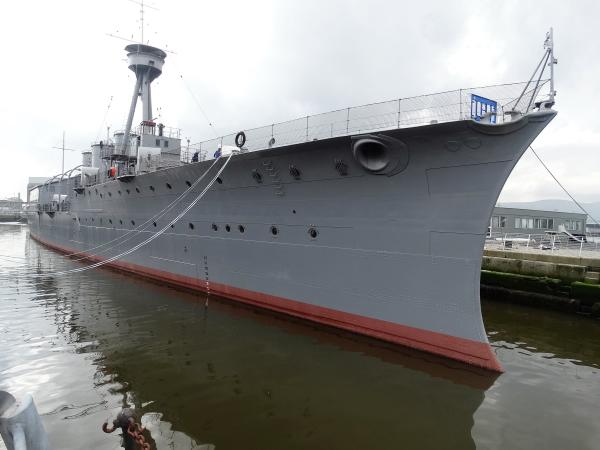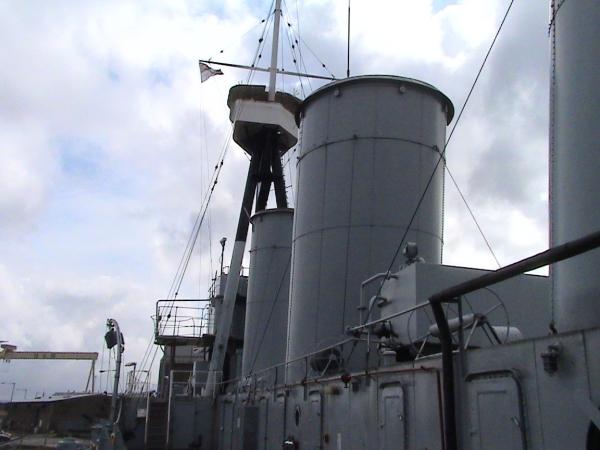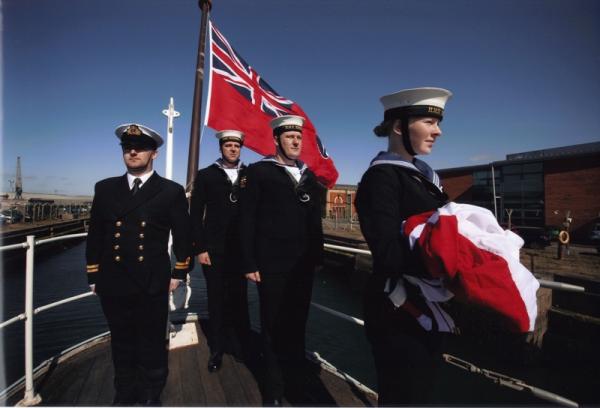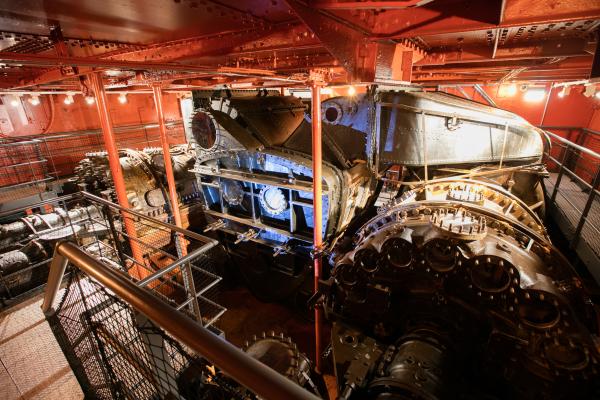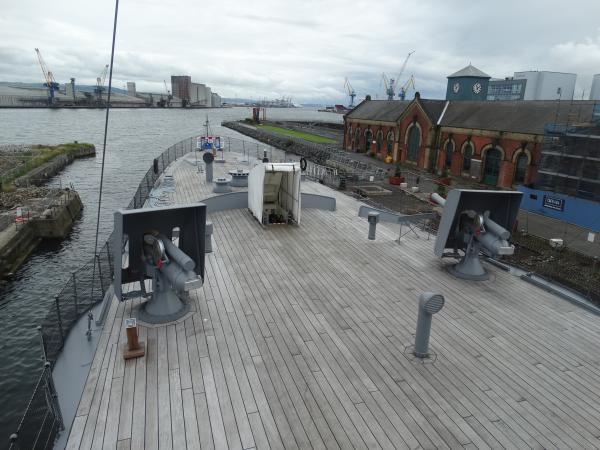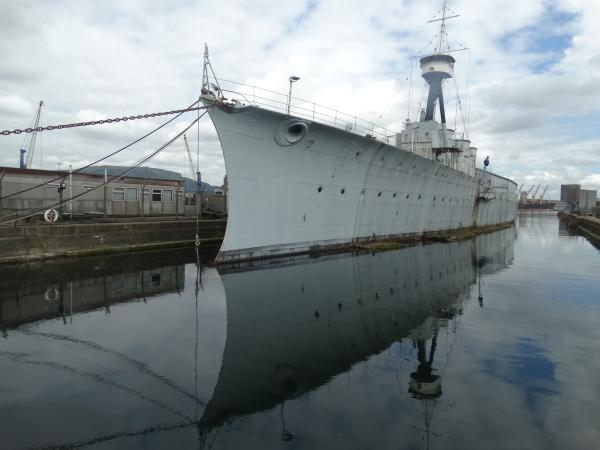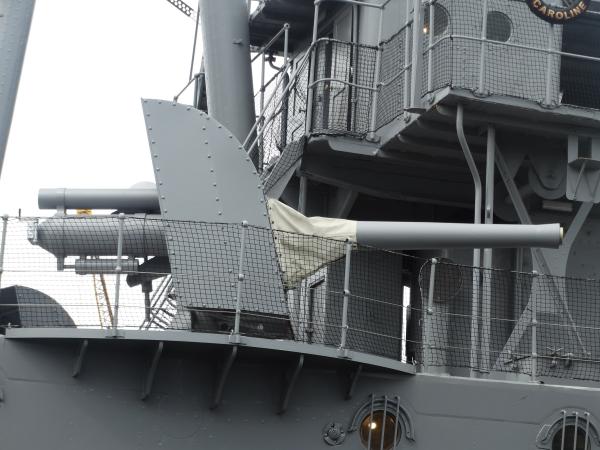

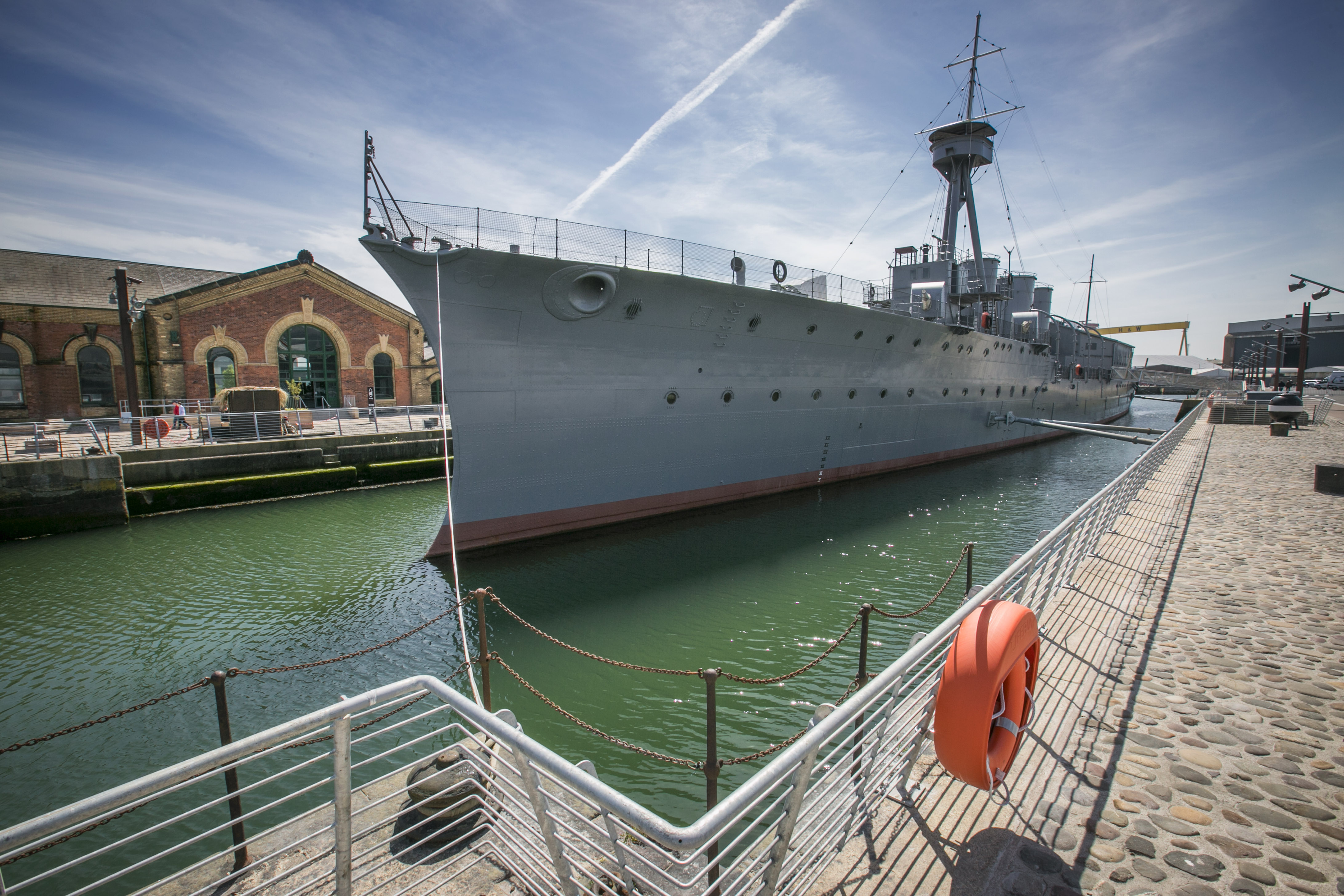
Details
Construction
Dimensions
History
HMS CAROLINE was the name ship of a class of six light cruisers built by Cammell Laird in time for the outbreak of the Great War. Launched and commissioned in 1914 she joined the Grand Fleet at Scapa Flow. In 1916 she was engaged in the Battle of Jutland.
In 1918 the Admiralty experimented with launching a light aircraft from a platform aboard a ship and HMS CAROLINE was the chosen vessel. In 1924, after two years on the reserve list, she was transferred to Northern Ireland as HQ for the local division of the RNVR and was converted for this new duty at Harland & Wolff's yard. In 1993 she became the Reserve Training Centre to recruit and train RNR officers and ratings.
At the time of her decommissioning in 2011 HMS CAROLINE was the second oldest commissioned ship in the Royal Navy - HMS Victory being the first. She is also the last surviving vessel of any nation which fought at the Battle of Jutland.
Now operated by the National Museum of the Royal Navy, HMS CAROLINE is a hugely popular visitor attraction and museum in Belfast, where she has been berthed for 99 years.
In June 2023, HMS CAROLINE was awarded the title of NHS-UK's Static Flagship of the Year in recognition of her planned public engagement into 2024 (which marks the centenary of her being berthed in Belfast), as well as the level of social media output and learning resources for schools.
Significance
1. What is the vessel’s ability to demonstrate history in her physical fabric?
Evidence for designs, functions, techniques, processes, styles, customs and habits or uses and associations in relation to events and people. How early, intact or rare these features are may impact on significance.
HMS CAROLINE was at the forefront of technological achievements in her day. She still holds the record for fastest build time of any major warship, having been completed in nine months in 1914. She was fitted with the latest in modern guns and gunnery controls, the latest armour, new radio communications, and the best of the new water tube boilers. The steam from these powered the newly developed Parson’s Pinion Geared Turbines, which enabled her to reach speeds of up to 30 knots that had been unachievable only a few years earlier in vessels fitted with the old reciprocating engines.
HMS CAROLINE’s turbines are still in situ on the ship. These are the only in situ turbines of this type anywhere in the world. HMS CAROLINE also burnt oil in her boilers, not coal, another technological revolution of the Edwardian Royal Navy. HMS CAROLINE therefore encapsulated a series of rapid technological advances between the late 1880s and 1914 that fundamentally changed warships and the way they fought. As such, HMS CAROLINE is a vital component of Britain‘s industrial and technological history as well as its naval past.
HMS CAROLINE is largely unchanged from the day she was built. She still has 85 percent of her original construction, which adds greatly to her significance. A major conservation project was completed in 2016 which returned her to her configuration at the time of the Battle of Jutland. Above deck large guns and torpedoes have been installed along with an anti-blast apron. Decking has been replaced, but original features include the living quarters and engine rooms, and the compasses and telegraphs on the bridge. The Captain’s, senior officers’ cabins and sick bay have been restored to their 1916 configuration. The First Rates Mess and galley kitchen have been converted to a café.
2. What are the vessel’s associational links for which there is no physical evidence?
Associations with people or places. Off-ship research.
Built in 1914, HMS CAROLINE is the only survivor of both the Grand Fleet and the Battle of Jutland, and as such she is of both national and international importance. She provides a vital source of evidence about Britain’s involvement in the First World War, and specifically in the Battle of Jutland. This battle was fought between the British Grand Fleet and the German High Seas Fleet in 1916. It was the largest surface naval battle of the modern era, and was the only major fleet action of the First World War. It also played a key role in the demise of battle cruisers. The Battle of Jutland is one of the most controversial naval actions in the Royal Navy's long history. HMS CAROLINE played a key role in this Battle, and despite being in the thick of the fighting, the ship was not hit and none of her crew were killed or injured during the battle. The personal accounts of some of the crew who were aboard HMS CAROLINE during the Battle of Jutland survive; their descriptions of the battle and of life on board provide an important additional dimension to the understanding of this historical event.
With the outbreak of the Second World War, HMS CAROLINE again assumed centre stage in the Battle of the Atlantic, one of the biggest naval battles of the war. At first, HMS CAROLINE offered signal and cipher facilities that were focused on detecting U-boats in the Irish Sea. By the end of 1940, she was the command base for seventy mine-sweeping and anti-submarine trawlers that travelled as far away as Canada to protect ships. By 1943, destroyers, corvettes and frigates were all using HMS CAROLINE as a base for anti-U-boat patrols. HMS CAROLINE thus provides a key link in telling an important story of collective involvement in the First World War, the Battle of Jutland and the Battle of the Atlantic in the Second World War. She also provides an important source of evidence for future generations. She has been recorded on the National Register of Historic Vessels since 1996 and is part of the National Historic Fleet.
3. How does the vessel’s shape or form combine and contribute to her function?
Overall aesthetic impact of the vessel, her lines, material she was built from and her setting. Does she remain in her working environment?
HMS CAROLINE has a dramatic and evocative presence, with her distinctive lines as a First World War light cruiser. Her bow is crescent-shaped to facilitate the ramming of submarines; she is the only ship in the world to have this style of bow. Formal decommissioning of HMS CAROLINE as a Royal Navy warship took place on 31 March 2011. She is currently located at Alexandra Dock, Belfast, Northern Ireland where she was home to the Ulster Division of the RNR between 1924 and 201. Between 2013-2016 she received extensive Heritage Lottery and Tourism Northern Ireland funding to safeguard her by making her wind and watertight and to present her as a high quality visitor attraction telling the story of life on board the ship throughout multiple periods of history, in times of war, peace and political upheaval in Northern Ireland. Whilst no longer operational, today HMS CAROLINE is a visitor experience in Belfast's Titanic Quarter, allowing visitors to discover a range of historic spaces including the Captain Crookes Cabin, engine room, sick bay and galley kitchen. Visitors can explore, through a mixture of historic restoration, state-of-the-art special effects and hands-on interactive exhibits, the importance of the Battle of Jutland and discover what life was like at sea for the over three hundred crew who served on board.
Source:
NHS-UK team, 05 January 2017.
This statement was developed as part of the Heritage Lottery funded First World War project. http://www.ww1britainssurvivingvessels.org.uk/
Key dates
-
1914
Built by Cammell Laird, Birkenhead as a Light Cruiser and launched by Lady Lawrence Power, wife of Admiral Lawrence Power
-
1914
Joined the Grand Fleet at Scapa Flow as part of the 4th Light Cruiser Squadron
-
1916
Participated in the Battle of Jutland and was heavily engaged by a German Battleship without sustaining severe damage
-
1917
Major refit
-
1918
Chosen in an Admiralty experiment to launch light aircraft from an on-board platform
-
1919
Sent to the East Indies Station
-
1922
Paid off and placed on the Reserve List
-
1924
Transferred to Belfast, Northern Ireland and converted for use as the Headquarters of the RNVR Ulster Division
-
1939
Became a Depot Ship for patrol craft based in Belfast
-
1946
Used once more as the HQ for the RNVR Ulster Division
-
1958-1993
Training for the RNR (Combined with the RNVR in 1958)
-
1993
Became the Reserve Training Centre to recruit and train RNR officers and ratings to support the Royal Navy
-
2011
Vessel decommissioned after being the longest commissioned ship after HMS VICTORY in the Royal Navy
-
2014
Physical safeguarding work begins
-
2016
HMS Caroline opens to the public as a visitor attraction
-
2023
Received the 2023 Static Flagship of the Year Award from National Historic Ships UK
Grants
-
2016
Tourism Northern Ireland granted £4,517,622 to present her as a high quality visitor attraction telling the story of life on board the ship throughout multiple periods of history, in times of war, peace and political upheaval in Northern Ireland
-
2014-2016
HMS Caroline recieved a grant of £1,097,423 to safeguard the vessel and make her wind and watertight
-
2013-2014
The Heritage Lottery Fund awarded £12,207,800 to present her as a high quality visitor attraction telling the story of life on board the ship throughout multiple periods of history, in times of war, peace and political upheaval in Northern Ireland
-
October 2012
A grant of up to £1million from the National Heritage Memorial Fund (NHMF) has been awarded to support the vessel which will now have a secure future in Belfast where people will be able to visit her and learn about her unique role in the First World War
Sources
R S Allison, HMS Caroline: A brief account of some warships bearing the name, and in particular of HMS Caroline (1914-1974), and of her part in the development of the Ulster Division, RNVR, and later RNR (1974) pub: Blackstaff Press for the Book Committee of HMS Car
Norman J Brouwer, International Register of Historic Ships (Edition 2, 1993, pp141) pub: Anthony Nelson
Dick Sullivan, Old Ships, Boats and Maritime Museums (1978) pub: Coracle Books
Classic Boat First World War survivor awarded ?1m pub: Posedon Press
Classic Boat (February , 2013, pp15) Belfast - First World War survivor awarded ?1m
Ships Monthly (June, 2003) A ticket to Ride
Own this vessel?
If you are the owner of this vessel and would like to provide more details or updated information, please contact info@nationalhistoricships.org.uk

